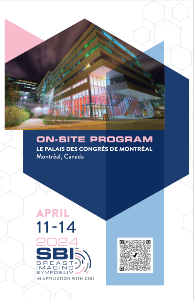Back
Session 5: Successful Implementation of a Same-Day Breast Biopsy Program in the Safety-Net Setting: Initiative to Mitigate Barriers to Care among Historically Underserved Groups
Saturday, April 13, 2024
1:30 PM – 2:30 PM
Location: 510B

Ivy Ewald, MD, MSc
Diagnostic Radiology Resident, R4
University of Colorado Anchutz Medical Center - - Aurora, CO
Abstract Presenter(s)
Purpose: Early breast cancer detection has been shown to improve breast cancer outcomes by identifying early-stage tumors amenable to curative treatment. However, women from historically underserved backgrounds including those from low socioeconomic, rural, and racial/ethnic minority backgrounds are more likely to experience delays in breast cancer care, which has been associated with adverse outcomes. Strategies to decrease delays in diagnosis and treatment include implementation of a same day biopsy (SDB) programs, which may help mitigate barriers to care experienced by these populations. We aimed to evaluate the feasibility and impact of implementing a SDB program within a safety-net setting, which cares for a larger proportion of historically underserved patients.
Materials and Methods: This study utilized an interrupted time series design with pre/post analyses. After IRB approval, all diagnostic and ultrasound examinations leading to biopsy pre- (May 2021 – April 2022) and post- (May 2022 – April 2023) implementation of our same-day biopsy program were identified. Demographic characteristics of the two groups using Wilcoxon rank-sum tests for continuous variables and chi-square tests of independence for categorical variables were evaluated. Spline modeling with generalized linear models was used to assess if days from biopsy recommendation to biopsy and rates of having a SDB differed between pre- and post-implementation groups.
Results: Among 521 patients who received recommended biopsies during the study period, 256 and 265 patients received biopsies in pre- and post-implementation periods, respectively. For all patients, the same-day biopsy program reduced the median time from biopsy recommendation to biopsy from 11.0 (IQR: 5.0 – 17.0) days to 6.0 (IQR: 2.0 – 11.0) days (P < .0001). For Black participants, median time from biopsy recommendation to biopsy decreased from 13.5 (IQR: 7.0-19.0) days to 7.0 (IQR: 5.0-14.0) days (P < .0001). For White participants, median time from biopsy recommendation to biopsy decreased from 10.5 (IQR: 6.0-16.5) days to 6.0 (IQR: 2.0-9.0) days (P < .0001). For Hispanic patients, median time from biopsy recommendation to biopsy decreased from 11.0 (IQR: 5.0-16.0) days to 6.0 (IQR: 2.5-8.0) days (P < .0001).
Conclusion: This study demonstrated successful implementation of a SDB program within a safety-net hospital setting, reducing overall time to biopsy among all racial and ethnic minority groups after abnormal diagnostic mammography.
Clinical Relevance Statement: Implementation of SDB programs can serve as an important tool in the safety-net setting, addressing complex disparities in care by consolidating breast imaging services and reducing barriers related to job, family, and cost considerations for our most vulnerable patients.
Materials and Methods: This study utilized an interrupted time series design with pre/post analyses. After IRB approval, all diagnostic and ultrasound examinations leading to biopsy pre- (May 2021 – April 2022) and post- (May 2022 – April 2023) implementation of our same-day biopsy program were identified. Demographic characteristics of the two groups using Wilcoxon rank-sum tests for continuous variables and chi-square tests of independence for categorical variables were evaluated. Spline modeling with generalized linear models was used to assess if days from biopsy recommendation to biopsy and rates of having a SDB differed between pre- and post-implementation groups.
Results: Among 521 patients who received recommended biopsies during the study period, 256 and 265 patients received biopsies in pre- and post-implementation periods, respectively. For all patients, the same-day biopsy program reduced the median time from biopsy recommendation to biopsy from 11.0 (IQR: 5.0 – 17.0) days to 6.0 (IQR: 2.0 – 11.0) days (P < .0001). For Black participants, median time from biopsy recommendation to biopsy decreased from 13.5 (IQR: 7.0-19.0) days to 7.0 (IQR: 5.0-14.0) days (P < .0001). For White participants, median time from biopsy recommendation to biopsy decreased from 10.5 (IQR: 6.0-16.5) days to 6.0 (IQR: 2.0-9.0) days (P < .0001). For Hispanic patients, median time from biopsy recommendation to biopsy decreased from 11.0 (IQR: 5.0-16.0) days to 6.0 (IQR: 2.5-8.0) days (P < .0001).
Conclusion: This study demonstrated successful implementation of a SDB program within a safety-net hospital setting, reducing overall time to biopsy among all racial and ethnic minority groups after abnormal diagnostic mammography.
Clinical Relevance Statement: Implementation of SDB programs can serve as an important tool in the safety-net setting, addressing complex disparities in care by consolidating breast imaging services and reducing barriers related to job, family, and cost considerations for our most vulnerable patients.

